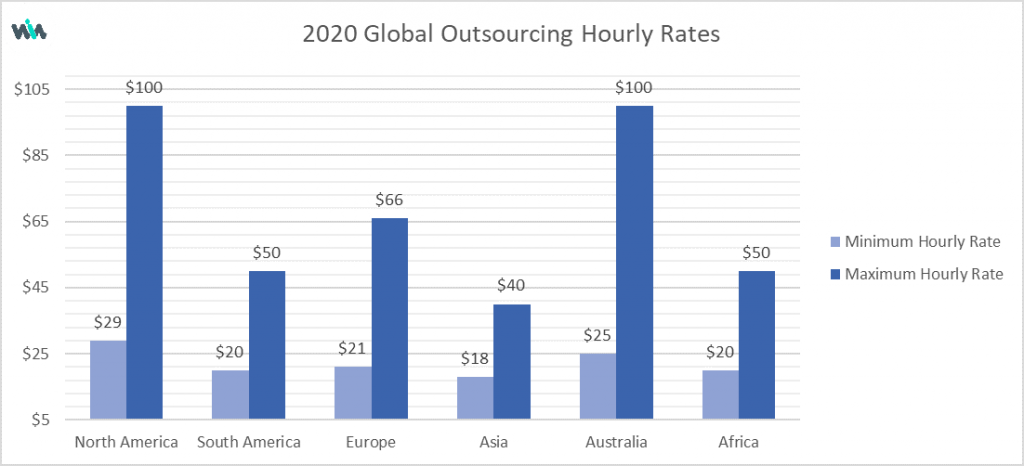WINaTALENT is a freelance website that offers various estimation services as well.
Our freelancers undergo a vetting process that thoroughly examines their expertise, skills, and communication abilities.
And our estimation services contain a scope, time, and budget estimate while considering the type of team you want to build and your location.
There are several different sections in our estimation document, but the three main factors we estimate are the three constraints of the iron triangle model:
- The deliverables (or the scope)
- The resources (the budget and the team’s effort)
- The timeline
These constraints are iron because they are interconnected; you cannot alter one without impacting the other two.
Though, a matter that impacts these three estimable and interconnected constraints is the type of team you’re aiming to build.
In-house teams, outsourcing companies, and freelancers
You have three options when you want to develop a new software product:
- Building an in-house team (or insourcing), which refers to conducting an operation within the company
- Outsourcing your product to another company
- Hiring freelancers who are self-employed individuals
Each option has its advantages and disadvantages.
There’s no “right” or “wrong” choice; you ought to weigh up your circumstances to decide on the best option.
But a notable factor to consider before choosing among these three options is their inexpensiveness.
Comparing in-house, outsource, and freelance software development’s inexpensiveness
Building an in-house team is typically a more expensive and time-consuming scenario.
Finding the right developer who matches all your requirements can be stressful and time-consuming. Retaining and covering their high salaries also increase your overheads notably.
Outsourcing your product can be a much more inexpensive alternative, especially with offshore companies.
In this option, you don’t have the expenses you cover while building an in-house team.
Nevertheless, outsourcing companies offer you a team of professionals for as long as you need, so there’s no need to train anyone (and this, in turn, reduces your overheads).
Hiring a freelancer is even less costly than the previous options since freelancers don’t have the overheads regular employees and outsourcing companies have.
Not to mention, you can hire freelancers from anywhere you want.
And since the rates are much lower overseas, hiring a freelancer from places like Asia or Eastern Europe reduces your expenses considerably.
Though, if you’re planning on working with outsourcing companies or freelancers, just like many other companies that are starting to entrust their software development to them, there are certain things you ought to know.
Despite its growth, research shows that “20 to 25% of all outsourcing relationships fail within two years, and 50% fail within five”.
But why does software outsourcing fail most of the time?
Well, the most important reason is that companies make ambiguous project estimates, or make no estimations at all, as they lack the required technical expertise.
In some cases, outsourcing companies propose unrealistic deadlines and estimates to clients when bidding for projects; clients accept these proposals because of their unfamiliarity. They attempt to save time and costs but fail in doing so.

The result is spending more money than expected and exceeding the timeline to redo the project.
Budget and schedule overruns can cause a project to deviate and even threaten the existence of a company.
A study published in Harvard Business Review stated that, on average, 27% of the 1,471 IT projects they analyzed had cost overruns, and 70% exceeded their timelines.
These overruns and project failures lead to outsourcing relationships’ failure as well.
It’s critical to make relatively precise estimations to avoid failure while outsourcing your software product.
Furthermore, meeting deadlines and budget estimates are the criteria that determine a project’s success.
Sometimes, clients have unclear expectations and objectives, but a software project’s successful implementation rests solely on the client’s goals and ideas.
Estimations help clients have concise standards and realistic goals about their software, which leads to the project’s success.
WINaTALENT’s estimations give you a clearer understanding of your product’s deliverables and what you must expect from your team.
How does WINaTALENT estimate the scope of your software project?
WINaTALENT uses a combination of traditional bottom-up techniques and top-down agile techniques to provide clients with approximate project estimates.
We estimate your project’s scope by classifying it into tangible themes, epics, and user stories; this is an initial high-level (or a general) estimation.
WINaTALENT starts with identifying the themes, which are a collection of epics that drive toward a common goal. Then, we continue to break themes into epics and epics into user stories.
To construct user stories, our team uses user story formats: as a ___, I want ___ so that ___.
For example, as an employer, I want to be able to view all the applicable candidates so that I can hire the best one.
The user story in the example above is a feature that enables employees to find the most suitable candidates for their offer.
Since software development is primarily user-centered, defining themes, epics, and user stories helps developers put actual end-users fist by putting themselves in their users’ shoes.
How does WINaTALENT assign story points to user stories to determine effort?
After depicting your project’s user stories, WINaTALENT’s team uses agile estimation techniques to assign story points to each user story; this is a more precise estimation after the previous high-level one.
Story points approximately determine the effort each user story needs for its completion, which is later converted into person-hour and money by our team.
But even though this estimation is more specific, it still leaves things flexible.
WINaTALENT uses agile techniques for the same reason; our estimations are a range of time and expenses based on many variables that leave lots of room for changes and flexibility.
There are five well-known agile estimation techniques that we use amongst our team:
- Planning Poker is a technique with a set of cards with Fibonacci sequence numbers appropriate for smaller teams
- T-shirt Sizes is an ideal technique for determining the backlog of large items
- Dot Voting helps prioritize several small items and is more of a decision-making tool rather than an agile estimation technique
- The Bucket System is for estimating a large number of items in a larger team
- Large/Uncertain/Small is similar to the bucket system and is for classifying a large number of items in a small group
Our estimations are complemented by previous software development projects’ data.
By going through projects similar to yours, we compare our new and old data to make our estimates more precise and accurate.
How does WINaTALENT estimate time and determine the timeline of your software project?
WINaTALENT converts effort into time by making predictions about the number of hours a single developer takes to complete a task after assigning story points to user stories and predicting their effort.
Then, we proceed to add these estimates up to determine the project’s timeline.
However, timeline estimation depends on three factors:
- The developing team’s experience, seniority, and velocity: Experienced teams will surely complete a task faster than a novice team. This quality is the team’s velocity, which affects the overall time a project takes to complete.
- The project’s scope and complexity: Large and complex projects take more time to complete compared to simpler ones since they have more features to develop. The System’s integration is also a factor to consider; this term defines the practice of combining different subsystems and components to make a more complete and complicated system. By adding additional subsystems, the time also increases exponentially.
- Risk factors: No matter how precise your estimations are or how well you have planned your project, there’s almost always some risk involved in software development. Unexpected complications, such as technical issues or a sudden growth in project requirements, all extend a project’s timeline.
Our team takes all the factors above into account while making time estimations.
Note that time and cost estimates are interconnected; if a project’s timeline increases, its costs grow as well.
How does WINaTALENT estimate the costs of your project?
WINaTALENT estimates your project’s timeline while considering all the factors we mentioned (and by considering the kind of team you want to build), and then, converts the time into costs.
Since rates differ considerably from region to region and with different technologies, our estimations consist of cost estimates in various locations and the different programming languages your project requires.
Costs of labor are higher in North America, Australia, and Europe compared to South America, Asia, and Africa.

Our estimates mainly compare outsourcing costs in some parts of Europe and Asia.
You can find out all you need to know about global outsourcing rates in another post.
How does WINaTALENT protect your software project’s copyright ownership?
Copyright ownership is a critical part of software development (especially when outsourcing).
The owner of a software product or a code is typically the one who has the right to make money from it, reproduce it and distribute copies of it.
One of the basic principles of copyright is that the code’s copyright ownership goes to the person who wrote it, but only after they finished writing it.
But if you decide to build an in-house team, you are going to be the owner of your code since you have commissioned the work, and the work is made-for-hire.
The same goes for working with outsourcing companies and freelancers in most cases, but things get tricky with offshore companies and foreign freelancers.
First off, copyright laws vary in different countries. There’s no such thing as an “international copyright law” that automatically protects a work throughout the world when you outsource your software product to an offshore company. Nevertheless, some countries have no copyright laws at all.
The court where the act of infringement occurs in handles infringement issues under its jurisdiction (and not your country). So you need to know the law if you want to avoid such complications.
WINaTALENT gives you all the information you need when working with outsourcing companies and freelancers.
In any case, we strongly propose having a written contract which consists of a clause that:
- Designates the work as made-for-hire
- Assigns the code to the client after it’s written
- Grants the client with a license to use the code
The contract is valid in every situation, so writing one is the best way to avoid copyright infringement.
